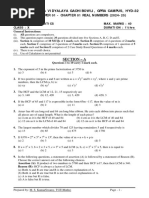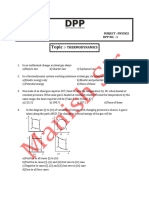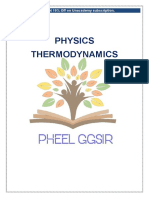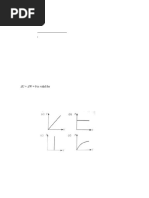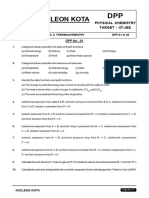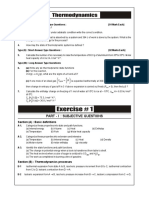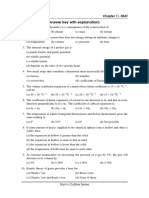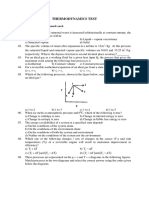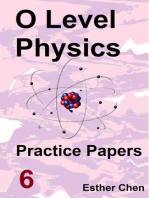DPP - 4
DPP - 4
Uploaded by
Alok RanjanCopyright:
Available Formats
DPP - 4
DPP - 4
Uploaded by
Alok RanjanCopyright
Available Formats
Share this document
Did you find this document useful?
Is this content inappropriate?
Copyright:
Available Formats
DPP - 4
DPP - 4
Uploaded by
Alok RanjanCopyright:
Available Formats
CLASS : XITH SUBJECT : PHYSICS
DATE : DPP NO. : 4
Topic :- THERMODYNAMICS
1. If the door of a refrigerator is kept open, then which of the following is true
a) Room is cooled b) Room is heated
c) Room is either cooled or heated d)Room is neither cooled nor heated
2. A Carnot engine whose efficiency is 40%, receives heat at 500 K. If the efficiency is to be 50%,
the source temperature for the same exhaust temperature is
a) 900 K b) 600 K c) 700 K d)800 K
3. An engine takes in compressed steam at 127℃ and rejects it at 47℃. Efficiency of the engine is
a) 60% b) 35% c) 20% d)40%
4. Two cylinders A and B fitted with pistons, contains equal number of moles of an ideal
monoatomic gas at 400 K. The piston of A is free to move while that of B is held fixed. Same
amount of heat energy is given to the gas in each cylinder. If the rise in temperature of the gas
in A is 42 K, the rise in temperature of the gas in B is (𝛾 = 5/3)
a) 25.2 K b) 35 K c) 42 K d)70 K
5. In an adiabatic process 90𝐽 of work is done on the gas. The change in internal energy of the gas
is
a) - 90 𝐽 b) +90 𝐽
c) 0 𝐽 d)Depends on initial temperature
6. If the heat 110 J is added to a gaseous system and it acquires internal energy of 40 J, then the
amount of internal work done is
a) 40 J b) 70 J c) 150 J d)110 J
7. A measure of the degree of disorder of a system is known as
a) Isobaric b) Isotropy c) Enthalpy d)Entropy
8. A thermodynamic system is taken through the cycle 𝐴𝐵𝐶𝐷 as shown in figure. Heat rejected
by the gas during the cycle is
D C
2P
Pressure
P
A B
V 3V
Volume
1
a) 2 𝑃𝑉 b) 4 𝑃𝑉 c) 2 𝑃𝑉 d)𝑃𝑉
9. Pressure 𝑝, volume 𝑉 and temperature 𝑇 of a certain material are related by 𝑝 = 𝛼𝑇2/𝑉, where
𝛼 is constant. Work done by the material when temperature changes from 𝑇2 to 2𝑇0 and
pressure remains constant is
3
a) 3𝛼𝑇20 b) 5𝛼𝑇20 c) 2𝛼𝑇20 d)7𝛼𝑇20
10. An ideal gas is allowed to expand freely against a vacuum in a rigid insulated container. The gas
undergoes
a) An increase in its internal energy
b) A decrease in its internal energy
c) Neither an increase nor a decrease in its temperature or internal energy
d)A decrease in temperature
11. When gas in a vessel expands its internal energy decreases. The process involved is
a) Isothermal b) Isobaric c) Adiabatic d)Isochoric
12. Which of the following is unique function of initial and final states?
a) dQ b) dW c) dU d) ∆𝑄 and ∆𝑊
13. A cyclic process for 1 mole of an ideal gas is shown in figure in the 𝑉-𝑇, diagram. The work
done in 𝐴𝐵, 𝐵𝐶 and 𝐶𝐴 respectively
V
C
V2
V1 A
B
O T
T1 T2
a) 0,𝑅𝑇2ln ( ),𝑅(𝑇1 - 𝑇2)
𝑉1
𝑉2
𝑉
b) 𝑅(𝑇1 - 𝑇2),0,𝑅𝑇1ln 𝑉1
2
c) 0,𝑅𝑇2ln ( ),𝑅(𝑇1 - 𝑇2) ( ),𝑅(𝑇2 - 𝑇1)
𝑉2 𝑉2
𝑉1
d)0,𝑅𝑇2ln 𝑉1
14. Which relation is correct for isometric process
a) ∆𝑄 = ∆𝑈 b) ∆𝑊 = ∆𝑈 c) ∆𝑄 = ∆𝑊 d)None of these
15. A cylindrical tube of uniform cross-sectional area 𝐴 is fitted with two air tight frictionless
pistons. The pistons are connected to each other by a metallic wire. Initially the pressure of
the gas is 𝑃0 and temperature is 𝑇0, atmospheric pressure is also 𝑃0. Now the temperature
of the gas is increased to 2𝑇0, the tension in the wire will be
a) 2𝑃0𝐴
b) 𝑃0𝐴
𝑃0𝐴
c) 2
d)4𝑃0𝐴
16. In the figure given two processes 𝐴 and 𝐵 are shown by which a thermo-dynamical system
`goes from initial to final state 𝐹. If ∆𝑄𝐴 and ∆𝑄𝐵 are respectively the heats supplied to the
systems then
P
A
i f
a) ∆𝑄𝐴 = ∆𝑄𝐵 b) ∆𝑄𝐴 ≥ ∆𝑄𝐵 c) ∆𝑄𝐴 < ∆𝑄𝐵 d) ∆𝑄𝐴 > ∆𝑄𝐵
17. An ideal Carnot engine whose efficiency is 40% receives heat at 500 K. If its efficiency were
50%, then in take temperature for same exhaust temperature would be
a) 700 K b) 900 K c) 800 K d)600 K
18. Two identical samples of a gas are allowed to expand (i) isothermally (ii) adiabatically. Work
done is
a) More in the isothermal process b) More in the adiabatic process
c) Neither of them d) Equal in both processes
19. The slopes of isothermal and adiabatic curves are related as
a) Isothermal curve slope = adiabatic curve slope
b) Isothermal curve slope = 𝛾 × adiabatic curve slope
c) Adiabatic curve slope = 𝛾 × isothermal curve slope
d)Adiabatic curve slope = 1/2 × isothermal curve slope
20. The state of a thermodynamic system is represented by
a) Pressure only b) Volume only
c) Pressure, volume and temperature d)Number of moles
You might also like
- E Shikshakosh Format NeDocument11 pagesE Shikshakosh Format NeAlok Ranjan60% (5)
- Maths Class X Chapter 01 Real Numbers Practice Paper 01 2024Document3 pagesMaths Class X Chapter 01 Real Numbers Practice Paper 01 2024Alok Ranjan67% (3)
- ALOHA Training Slides PDFDocument94 pagesALOHA Training Slides PDFArcangelo Di Tano0% (1)
- 50Q_-_ThermodynamicsDocument10 pages50Q_-_Thermodynamicsms1206927No ratings yet
- DPP - 6Document4 pagesDPP - 6Alok RanjanNo ratings yet
- Thermodynamics 1 0df4f738 588a 4bdf A3ea 851471138ddeDocument91 pagesThermodynamics 1 0df4f738 588a 4bdf A3ea 851471138ddeAnkit SinghNo ratings yet
- Thermodynamics DPP 1Document3 pagesThermodynamics DPP 1shubhamauddhyaNo ratings yet
- Thermodynamics DPP 5Document4 pagesThermodynamics DPP 5shubhamauddhyaNo ratings yet
- Maha DPP - ThermodynamicsDocument8 pagesMaha DPP - ThermodynamicsVaibhav Magic musicNo ratings yet
- Phy - DPP - Thermodynamics 06Document12 pagesPhy - DPP - Thermodynamics 06pirzadaharis030No ratings yet
- Physics Thermodynamics: GgliveDocument12 pagesPhysics Thermodynamics: GgliveChinmaya VastradNo ratings yet
- DPP - 8Document4 pagesDPP - 8Alok RanjanNo ratings yet
- DPP - 1Document3 pagesDPP - 1Alok RanjanNo ratings yet
- Thermodynamics DPP-7Document3 pagesThermodynamics DPP-7shubhamauddhyaNo ratings yet
- Top Q - Thermodynamics - IDocument5 pagesTop Q - Thermodynamics - IshreyanajreNo ratings yet
- Assignment 6 Thermodynamics 2022Document3 pagesAssignment 6 Thermodynamics 2022ayeshadostmuhammad79No ratings yet
- ASNMT Thermodynamics 24 SEPDocument4 pagesASNMT Thermodynamics 24 SEPViswanathan SrkNo ratings yet
- 2nd Year Phy Mcqs Past PapersDocument31 pages2nd Year Phy Mcqs Past PapersNazia AliNo ratings yet
- Heat and ThermodynamicsDocument47 pagesHeat and ThermodynamicsCh asimNo ratings yet
- StudyQuestionsE2 211Document9 pagesStudyQuestionsE2 211NurudeenNo ratings yet
- Thermodynamics DPP 8Document4 pagesThermodynamics DPP 8shubhamauddhyaNo ratings yet
- Microsoft Word Chapter 15Document20 pagesMicrosoft Word Chapter 15Shashank ShekharNo ratings yet
- Crash XII Test # 01Document6 pagesCrash XII Test # 01Kamran AliNo ratings yet
- E10 Questions PDFDocument7 pagesE10 Questions PDFmail2sgarg_841221144No ratings yet
- HeatDocument12 pagesHeatMuneer KaleriNo ratings yet
- ThermodynamicsDocument6 pagesThermodynamicsPrincess LlaneraNo ratings yet
- Test ID-416-PCMDocument12 pagesTest ID-416-PCMsuryavanshisatya48No ratings yet
- DPP - 2Document3 pagesDPP - 2Alok RanjanNo ratings yet
- Thermodynamics and Kinetic Theory of GasesDocument4 pagesThermodynamics and Kinetic Theory of GasesTarun GuptaNo ratings yet
- Exam 1 AnswersDocument6 pagesExam 1 AnswersAdham EmadNo ratings yet
- Engineering Thermodynamics (Mech 2203)Document4 pagesEngineering Thermodynamics (Mech 2203)kingsukbarman07No ratings yet
- SR Iit Star Model - A&apex - Jee Main PTM-16 (Pt-16-Syllabus) Mock Test QP (19-11-24)Document12 pagesSR Iit Star Model - A&apex - Jee Main PTM-16 (Pt-16-Syllabus) Mock Test QP (19-11-24)Kalyani NaiduNo ratings yet
- DPP-18 (Thermodynamics)Document4 pagesDPP-18 (Thermodynamics)Dushyanth S JNo ratings yet
- XI PHYSICS THERMODYNAMICSDocument4 pagesXI PHYSICS THERMODYNAMICSchikalol705No ratings yet
- XII Physics Irfan Sanjrani-1Document3 pagesXII Physics Irfan Sanjrani-1jaipal singhNo ratings yet
- Class 11 Phy Thermodynamics WorksheetDocument19 pagesClass 11 Phy Thermodynamics Worksheets.karthick5583No ratings yet
- ديناميكا حراريةDocument41 pagesديناميكا حراريةmaryam24902No ratings yet
- Thermal Physics TestDocument3 pagesThermal Physics TestsawalsharvariNo ratings yet
- MCQ ThermodynamicsDocument5 pagesMCQ Thermodynamicsastitvabansal1No ratings yet
- Revision Test On Heat & ThermodynamicsDocument6 pagesRevision Test On Heat & ThermodynamicsKartik BhureNo ratings yet
- Objectives ThermodynamicsDocument5 pagesObjectives ThermodynamicsM.ThirunavukkarasuNo ratings yet
- VVIMP QUESTIONS Basic Physics (22102)Document5 pagesVVIMP QUESTIONS Basic Physics (22102)Prathamesh Nawale100% (2)
- Exam 1Document5 pagesExam 1Adham EmadNo ratings yet
- Full Length Model Paper Wbut 2 Semester Engineering Thermodynamics & Fluid Mechanics ME 201 GROUP A (Multiple Choice Type Questions)Document4 pagesFull Length Model Paper Wbut 2 Semester Engineering Thermodynamics & Fluid Mechanics ME 201 GROUP A (Multiple Choice Type Questions)soumodip chakrabortyNo ratings yet
- UNIT 5 (THERMODYNAMICS) Physics (Self Assessment 5)Document5 pagesUNIT 5 (THERMODYNAMICS) Physics (Self Assessment 5)zunnoorainqureshiNo ratings yet
- 11th Physics Ch-11 - Thermodynamics (SQP) 2023-24Document10 pages11th Physics Ch-11 - Thermodynamics (SQP) 2023-24Mahalaksshmi .DNo ratings yet
- THEORY BASED H&TDocument7 pagesTHEORY BASED H&TPriyanshu BhagatNo ratings yet
- Thermodynamics & Thermochemistry DPPDocument35 pagesThermodynamics & Thermochemistry DPPjaviyahitarth1No ratings yet
- Appsc Mech PPRDocument20 pagesAppsc Mech PPRRajat YadavNo ratings yet
- Chemistry GRD 12 BestDocument8 pagesChemistry GRD 12 BestRkb Mlsdba LasyefNo ratings yet
- Part - I: Subjective Questions: Section (A) : Basic DefinitionsDocument20 pagesPart - I: Subjective Questions: Section (A) : Basic DefinitionsVedansh KeshariNo ratings yet
- SGU-PHYSICS RemovedDocument6 pagesSGU-PHYSICS RemovedTG ADIROCKNo ratings yet
- Full Unit Test 5Document10 pagesFull Unit Test 5bearingserbNo ratings yet
- Chemistry Enthalpy (Thermodynamic Reactions) WorksheetDocument3 pagesChemistry Enthalpy (Thermodynamic Reactions) Worksheetgeaalt2No ratings yet
- DPP-9Document3 pagesDPP-9a.gopinath.jeeNo ratings yet
- Chapter - 10Document7 pagesChapter - 10Mosabbir HossainNo ratings yet
- EXERCISE 11.1: (Answer Key With Explanation)Document24 pagesEXERCISE 11.1: (Answer Key With Explanation)John MarksNo ratings yet
- KeyOne Score TestDocument28 pagesKeyOne Score TestrobloxgamersgodNo ratings yet
- Thermodynamics 19092013Document5 pagesThermodynamics 19092013hellow3533No ratings yet
- DOC-20240503-WA0023(1)Document2 pagesDOC-20240503-WA0023(1)hamzashah1282yahooNo ratings yet
- Answer The Following Questions: A) 1.2x10 Pa B) 2.4x10 Pa C) 3.0x10 Pa D) 4.1x10 PaDocument3 pagesAnswer The Following Questions: A) 1.2x10 Pa B) 2.4x10 Pa C) 3.0x10 Pa D) 4.1x10 PaAhmad100% (1)
- maths-class-x-sample-paper-test-04-for-board-exam-2025-answers-1Document13 pagesmaths-class-x-sample-paper-test-04-for-board-exam-2025-answers-1Alok RanjanNo ratings yet
- Phy X_020618Document8 pagesPhy X_020618Alok RanjanNo ratings yet
- Bihar_2324 (1)Document897 pagesBihar_2324 (1)Alok RanjanNo ratings yet
- 4605854-Class 11 - Physics - Thermodynamics - WS - RandhirDocument4 pages4605854-Class 11 - Physics - Thermodynamics - WS - RandhirAlok RanjanNo ratings yet
- Bihar Board Class 12 Maths Model Question Paper 2021Document29 pagesBihar Board Class 12 Maths Model Question Paper 2021Alok RanjanNo ratings yet
- Class 8 Light and Vision Solved Test Paper Mcq (3)Document3 pagesClass 8 Light and Vision Solved Test Paper Mcq (3)Alok RanjanNo ratings yet
- Bihar Board 9th Class Registration Form 2024 PDFDocument3 pagesBihar Board 9th Class Registration Form 2024 PDFAlok RanjanNo ratings yet
- maths-class-xii-sample-paper-test-04-for-board-exam-2025-qpDocument6 pagesmaths-class-xii-sample-paper-test-04-for-board-exam-2025-qpAlok RanjanNo ratings yet
- Temperature Conversion Worksheet 3Document2 pagesTemperature Conversion Worksheet 3Alok RanjanNo ratings yet
- NCERT Nichod ChemistryDocument4 pagesNCERT Nichod ChemistryAlok RanjanNo ratings yet
- VIII 082934Document4 pagesVIII 082934Alok RanjanNo ratings yet
- 11 Year Biology Pyq 2013-23Document11 pages11 Year Biology Pyq 2013-23Alok RanjanNo ratings yet
- PDF ResizeDocument4 pagesPDF ResizeAlok RanjanNo ratings yet
- BPSC HM 31 May 2022 Exam PaperDocument26 pagesBPSC HM 31 May 2022 Exam PaperAlok RanjanNo ratings yet
- BPSC AbsentyDocument1 pageBPSC AbsentyAlok RanjanNo ratings yet
- Section CDocument2 pagesSection CAlok RanjanNo ratings yet
- Class 8 DPP FinalDocument188 pagesClass 8 DPP FinalAlok RanjanNo ratings yet
- Jeenspsu 03Document10 pagesJeenspsu 03Alok RanjanNo ratings yet
- Cet 6 Nov MorningDocument21 pagesCet 6 Nov MorningAlok RanjanNo ratings yet
- Spell Bee 6 To 8Document8 pagesSpell Bee 6 To 8Alok RanjanNo ratings yet
- CTET2Cert 20231113t19f8caDocument1 pageCTET2Cert 20231113t19f8caAlok RanjanNo ratings yet
- Perfection Coaching Point: Numerical Problems On Concave MirrorDocument4 pagesPerfection Coaching Point: Numerical Problems On Concave MirrorAlok RanjanNo ratings yet
- Order 9076, Dt-11.11.2023Document1 pageOrder 9076, Dt-11.11.2023Alok RanjanNo ratings yet
- Letter From Education Department To DEODocument3 pagesLetter From Education Department To DEOAlok RanjanNo ratings yet
- Appointment Letter 1Document1 pageAppointment Letter 1Alok RanjanNo ratings yet
- Ncert Solutions: ClassDocument11 pagesNcert Solutions: ClassAlok RanjanNo ratings yet
- VI_Air and Atmosphere_ICSEDocument45 pagesVI_Air and Atmosphere_ICSESandeep BrajNo ratings yet
- Lab 1 thermo-ANSDocument3 pagesLab 1 thermo-ANSAj MirandaNo ratings yet
- IDP by Shaahid (1) GFDFDDDDocument38 pagesIDP by Shaahid (1) GFDFDDDShaik ShaahidNo ratings yet
- Soda BottleDocument3 pagesSoda BottleBenedick CruzNo ratings yet
- Geography Form 1 - Marking SchemeDocument4 pagesGeography Form 1 - Marking SchemeFredrick LangatNo ratings yet
- Unit - I: Introduction To Environmental Studies and EcosystemDocument79 pagesUnit - I: Introduction To Environmental Studies and EcosystemDina GaranNo ratings yet
- NCERT Exemplar For Class 9 Science Chapter 1 - Matter in Our Surroundings (Book Solutions)Document15 pagesNCERT Exemplar For Class 9 Science Chapter 1 - Matter in Our Surroundings (Book Solutions)ankurmall817No ratings yet
- GR 10 Exp 1 MEMO Melting Curve 2024Document5 pagesGR 10 Exp 1 MEMO Melting Curve 2024masimbongengubane3No ratings yet
- Climate Change EssayDocument12 pagesClimate Change Essayapi-548928107No ratings yet
- Our Solar SystemDocument2 pagesOur Solar SystemdsjkfhkjsdhfNo ratings yet
- Kyoto Protocol UPSC NotesDocument3 pagesKyoto Protocol UPSC NotesSanchit RanaNo ratings yet
- Pressure in Fluids MSDocument6 pagesPressure in Fluids MSsaedghkh9No ratings yet
- Vapour Absorption System NotesDocument12 pagesVapour Absorption System NotesManik SharmaNo ratings yet
- Dokumen - Tips Chapter 7 Compressible FlowDocument74 pagesDokumen - Tips Chapter 7 Compressible Flowinam vfNo ratings yet
- Earth Science: Earth's Internal HeatDocument12 pagesEarth Science: Earth's Internal HeatAngel Akiko AlbertoNo ratings yet
- Unit 3 The Atmosphere: StructureDocument19 pagesUnit 3 The Atmosphere: Structurepradeep aryaNo ratings yet
- Carbon Cycle and Energy Flow Quiz ReviewDocument3 pagesCarbon Cycle and Energy Flow Quiz ReviewAbbas khan100% (1)
- PHY 210 Chapter 6 - 230615 - 000222 - 230615 - 143922Document46 pagesPHY 210 Chapter 6 - 230615 - 000222 - 230615 - 143922hidayahtul adhaNo ratings yet
- 4 H-TDocument32 pages4 H-TArbaz ButtNo ratings yet
- Reading Comprehension and Creative Writing 7Document1 pageReading Comprehension and Creative Writing 7Marco A. RomeroNo ratings yet
- Interstellar Testing Centre Pvt. LTD.: Test ReportDocument2 pagesInterstellar Testing Centre Pvt. LTD.: Test ReportDemon barberNo ratings yet
- City Light Pollution Policy Pitch Deck by SlidesgoDocument42 pagesCity Light Pollution Policy Pitch Deck by SlidesgoYousef El MasryNo ratings yet
- Virial's EquationDocument9 pagesVirial's EquationMarcus NguyễnNo ratings yet
- Chm1 Gasses 1005 FDDocument14 pagesChm1 Gasses 1005 FDaerkn skjksNo ratings yet
- Industrial & Commercial Refrigeration Products: 800.96.HENRYDocument10 pagesIndustrial & Commercial Refrigeration Products: 800.96.HENRYDASIHER2111No ratings yet
- Three Branches of Fluid MechanicsDocument47 pagesThree Branches of Fluid MechanicsJemuel FloresNo ratings yet
- Gujarat State Petronet LTD Sn10 Eia2Document125 pagesGujarat State Petronet LTD Sn10 Eia2cherryNo ratings yet
- Wine Quality Classification Using WekaDocument74 pagesWine Quality Classification Using Wekababuraogapte30No ratings yet
- S10MT IIj 20 CHARLES LAW ABUEVA R1Document2 pagesS10MT IIj 20 CHARLES LAW ABUEVA R1Leil RiegoNo ratings yet

